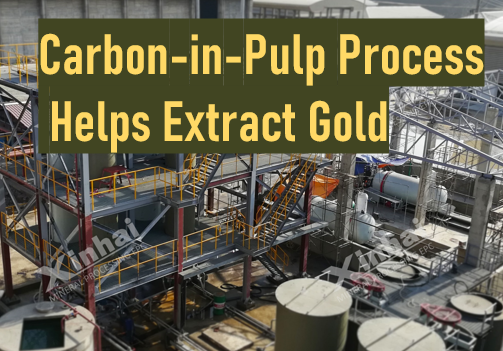Carbon-in-Pulp Process Helps Extract Gold
2024-09-13 Xinhai (925)
2024-09-13 Xinhai (925)
If you have any questions, please contact us through the following ways, we will give you more and better assistance!

Gold ore carbon-in-pulp method, that is, full mud cyanide carbon-in-pulp method for gold extraction, is one of the main methods for cyanide gold extraction. This process is to grind all the gold ore into pulp, first cyanide leaching, then use activated carbon to directly adsorb the dissolved gold from the pulp, and then extract the gold mud through carbon desorption and electrolysis, so as to achieve gold recovery.
The carbon-in-pulp method is suitable for processing low-grade, complex and fine-grained impregnated gold ores, such as impregnated gold ore, amalgam or gravity separation tailings, and muddy oxidized ore.

The raw ore is crushed through two to three closed-circuit processes, and the powder ore particle size reaches -12mm. Subsequently, the ore is subjected to two stages of grinding treatment, and the fineness reaches at least 80%-200 mesh. After crushing and grinding, since the concentration of the pulp after grinding and classification does not meet the standard of cyanide leaching, it needs to be concentrated and dehydrated. The pulp is dehydrated by a high-efficiency concentrator, and impurities such as sawdust are removed from the pulp, so that the pulp concentration is increased to 40-42% to meet the requirements of cyanide leaching.
The cyanide pulp after impurity removal and concentration is sent to multiple stepped leaching tanks for leaching under appropriate temperature, pH value and oxygen content conditions. Sodium cyanide reacts chemically with gold minerals, and gold is dissolved and converted into gold cyanide complex. In order to ensure that the reaction is fully carried out, the pulp needs to be stirred continuously during the leaching process, usually using 5 to 8 stirring tanks, which is similar to the conventional cyanidation method. At the same time, the leaching time and reagent concentration need to be strictly controlled to increase the leaching rate of gold.
After the pulp after cyanide leaching is introduced into the adsorption tank, the activated carbon begins to adsorb. Because the activated carbon has a highly developed pore structure and a huge specific surface area, it can fully contact with the pulp and efficiently adsorb gold ions in the solution by countercurrent adsorption. In this process, the gold cyanide complex is transferred from the solution to the surface of the activated carbon to form gold-loaded carbon. In order to achieve the reverse flow of activated carbon and slurry, the adsorption tank is equipped with a carbon screen and a slurry lifter to improve the adsorption efficiency of gol
The desorption electrolysis process of gold-loaded carbon is usually combined with electrolytic deposition equipment to form a production circulation system. First, the gold-loaded carbon is loaded into the desorption tower, and the prepared desorption liquid is pumped into the system. The desorption methods mainly include normal temperature and pressure desorption method and high temperature and high pressure desorption method. During the desorption process, anions that are easily adsorbed by activated carbon are added to the desorption liquid, thereby replacing the gold-cyanide complex and achieving gold desorption.